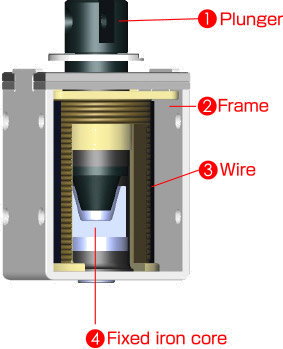This is a solenoid’s driving part. When a magnetic field is emitted, it is drawn toward the fixed iron core. |
Made up mainly of a magnetic substance, this is manufactured with holes (taps) on most solenoids. |
This is the main part of the solenoid that emits a magnetic field when electric current flows through it. Together, the bobbin, wire, lead and exterior tape are called the coil. Some coils have temperature fuses or diodes on the inside. |
When a magnetic field is emitted from the coil, it attracts the moveable iron core along the magnetic flux. The shape of the moveable and fixed iron cores and the attraction characteristics are intimately related. |


